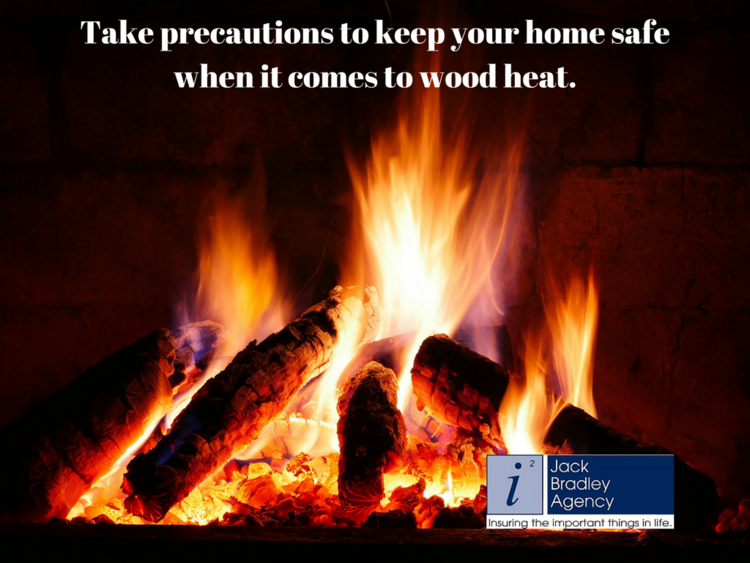
Do you take advantage of wood heat?
We at Jack Bradley Agency want to remind you to be safe this winter if you burn wood within your home. Heating with wood can be one of the most efficient and enjoyable ways to heat your home. Not only is it a cost savings but it’s also a good opportunity to get some exercise. Here are a few thoughts that will help you get the most out of your wood heat this winter.
1. Have your chimney or flue inspected.
Be sure you are ready for the wood burning season. We recommend having a professional come out for an inspection. Nesting animals and creosote buildup could cause major problems if not removed from your chimney.
2. Burn seasoned firewood only.
Whether you are burning in a fireplace, insert, or freestanding stove seasoned firewood is the key. The time it takes freshly split wood to become fully seasoned will vary with the type of wood, its thickness, and the local weather. As a general rule, one should allow a year for wood to dry for efficient, clean indoor burning. Cracks in the ends of the wood are an indication that it is fully seasoned and ready for burning. You can also test whether the wood is fully seasoned by striking two pieces together. Dry wood gives a sharp ‘crack’ while unseasoned wood sounds more like a dull ‘thud’. Unseasoned firewood provides less heat when burned, yet releases more smoke and contributes to hazardous creosote buildup in chimneys.
3. Split your firewood.
Wood dries from the surface inward, so un-split wood dries very slowly. The more surface wood is exposed by splitting, the faster the wood will dry. Stack the wood loosely to promote air circulation.
4. Store wood outside, covered on top with sides open to air.
Cut, split and stack firewood in a place sheltered from the weather, but not covered on the sides, so as to optimize air circulation. Block up the bottom row of wood several inches off the ground. During snowfalls, throw a tarp over the woodpile to keep blowing snow out of the stacked wood.
5. Store only a small amount of wood inside your home.
Bringing large amounts of firewood into the home can bring in unwanted guests. When lifting from the woodshed or into the carrying box, or wood sling, a quick tap against a hard surface will release any spiders or other critters that otherwise will be brought into your home.
6. Split wood into pieces 4-6 inches in diameter.
Firewood will burn cleaner when more surface area is exposed to the flame. Use the smaller split pieces to get the fire started, and only use larger pieces of wood once the fire is well established.
7. Make sure your fire is getting enough air.
This will ensure it burns hot and clean. Check the air intake of your heater to ensure there are no blockages from dust balls and spider webs. A properly burning fireplace is hotter, produces less smoke and is more efficient. This means more warmth for less money.
8. Don’t stuff too much wood inside the firebox.
Overloading the firebox can reduce the amount of air needed for a good burn. Refuel more often with smaller loads with the air inlet open to keep the fire burning briskly when you are at home. If you need to shut the fire down, wait until it is well-established before turning down the damper. If you throw a fresh log in just before closing the damper, it may smolder for some time before reaching a cleaner burn.
9. Keeping the fire burning overnight
Most wood stoves and inserts struggle to maintain a continual fire for 7 or more hours. In the evening when placing the last load in the heater be sure to add large well-seasoned hardwood logs. Close the damper and slightly close the air inlets to reduce air flow. The next morning you should have a well-established coal bed to easily re-start the fire.
10. Never burn:
Plastics
Glossy magazines or newsprint
Painted or treated woo
Foil or metallic-coated gift wrap
Particle board
Household garbage (diapers, plastic bags, etc.)
Plywood
Rags or fabrics made of synthetic materials
These items release toxic chemicals into the air that can be harmful to your health and damage your stove or fireplace.

Discussion
There are no comments yet.